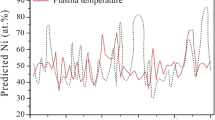Abstract
Laser welding, as an advanced manufacturing technology, involves drastic and complicated interaction between laser energy and material. The whole process is a strong-coupling nonlinear system. Therefore, it is considered a great challenge to conduct accurate modeling on laser welding process. This paper proposes a novel data-driven based method for investigating and modeling nonlinear laser welding process. The system consists of six types of sensor, including visible sensing photodiode, laser reflection sensing photodiode, spectrometer, visible sensing camera, auxiliary illumination sensing camera, and X-ray sensing camera. The sensors help to synchronously obtain optical features, chemical properties, and physical characteristics during laser welding process. A multiple-input multiple-output (MIMO) Hammerstein-Wiener model was constructed and identified by the experimental data collected from the multiple-sensing system. It is concluded that the system designed in this research provides accurate and valid data for making comprehensive analyzing and modeling of laser welding process.
Similar content being viewed by others
References
Li CB, Liu LM (2013) Investigation on weldability of magnesium alloy thin sheet T-joints: arc welding, laser welding, and laser-arc hybrid welding. Int J Adv Manuf Technol 65(1–4):27–34
Ren DX, Liu LM, Li YF (2012) Investigation on overlap joining of AZ61 magnesium alloy: laser welding, adhesive bonding, and laser weld bonding. Int J Adv Manuf Technol 61(1–4):195–204
Zhang LG, Ye QX, Yang W, Jiao JB (2014) Weld line detection and tracking via spatial-temporal cascaded hidden Markov models and cross structured light. IEEE Trans Instrum Meas 63(4):742–753
Gao XD, Zhong XG, You DY, Katayama S (2013) Kalman filtering compensated by radial basis function neural network for seam tracking of laser welding. IEEE Trans Control Syst Technol 21(5):1916–1923
Cho WI, Na SJ, Thomy C, Vollertsen F (2012) Dynamic keyhole profile during high-power deep-penetration laser welding. J Mater Process Technol 21(1):262–275
You DY, Gao XD, Katayama S (2014) Review of laser welding monitoring. Sci Technol Weld Join 19(12):181–201
Paleocrassas AG, Tu JF (2010) Inherent instability investigation for low speed laser welding of aluminum using a single-mode fiber laser. J Mater Process Technol 210(10):1411–1418
Kong F, Ma J, Carlson B, Kovacevic R (2012) Real-time monitoring of laser welding of galvanized high strength steel. Opt Laser Technol 44(7):2186–2196
Moon HS, Kim YB, Beattie RJ (2006) Multi sensor data fusion for improving performance and reliability of fully automatic welding system. Int J Adv Manuf Technol 28(3–4):286–293
Fan CJ, Lv FL, Chen SB (2009) Visual sensing and penetration control in aluminum alloy pulsed GTA welding. Int J Adv Manuf Technol 42(1–2):126–137
Esfahani ET, Wang S, Sundararajan V (2014) Multisensor wireless system for eccentricity and bearing fault detection in induction motors. IEEE/ASME Trans Mechatron 19(3):818–826
Leonardo N, Ronald T, Andreas H, Andreas B, and Heinrich H (2012) Novel algorithm for the real time multi-feature detection in laser beam welding. IEEE International Sympo. on Circuits and Systems 181–184.
Keuster JD, Duflou JR, Kruth JP (2007) Monitoring of high-power CO2 laser cutting by means of an acoustic microphone and photodiodes. Int J Adv Manuf Technol 35(1–2):115–126
Rodil SS, Gómez RA, Bernárdez JM, Rodríguez F, Miguel LJ, Perán JR (2010) Laser welding defects detection in automotive industry based on radiation and spectroscopical measurements. Int J Adv Manuf Technol 49(1–4):133–145
Yu HW, Ye Z, Chen SB (2013) Application of arc plasma spectral information in the monitor of Al–Mg alloy pulsed GTAW penetration status based on fuzzy logic system. Int J Adv Manuf Technol 68(9–12):2713–2727
GriemHR. Principle of plasma spectroscopy. Cambridge monographs on plasma physics. Cambridge: Cambridge University Press;1997.
Jager M, Humbert S, Hamprecht FA (2008) Sputter tracking for the automatic monitoring of industrial laser-welding processes. IEEE Trans Ind Electron 55(5):2177–2184
Heider A, Sollinger J, Abt F, Boley M, Weber R, Graf T (2013) High-speed X-ray analysis of spatter formation in laser welding of copper. Phys Procedia 41:112–118
Li SC, Chen GY, Zhang M, Zhou Y, Zhang Y (2014) Dynamic keyhole profile during high-power deep-penetration laser welding. J Mater Process Technol 214(3):565–570
Gao XD, Chen YQ (2014) Detection of micro gap weld using magneto-optical imaging during laser welding. Int J Adv Manuf Technol 73(1–4):23–33
Chen ZQ, Gao XD (2014) Detection of weld pool width using infrared imaging during high-power fiber laser welding of type 304 austenitic stainless steel. Int J Adv Manuf Technol 74(9–12):1247–1254
Zhang YX, Gao XD (2014) Analysis of characteristics of molten pool using cast shadow during high-power disk laser welding. Int J Adv Manuf Technol 70(9):1979–1988
Wang DQ, Ding F (2008) Extended stochastic gradient identification algorithms for Hammerstein-Wiener ARMAX systems. Comput Math Appl 56(12):3157–3164
Bai EW (1998) An optimal two-stage identification algorithm for Hammerstein-Wiener nonlinear systems. Automatica 34(3):333–338
Salimifard M, Jafari M, Dehghani M (2012) Identification of nonlinear MIMO block-oriented systems with moving average noises using gradient based and least squares based iterative algorithms. Neurocomputing 94:22–31
Author information
Authors and Affiliations
Corresponding author
Rights and permissions
About this article
Cite this article
You, D., Gao, X. & Katayama, S. Data-driven based analyzing and modeling of MIMO laser welding process by integration of six advanced sensors. Int J Adv Manuf Technol 82, 1127–1139 (2016). https://doi.org/10.1007/s00170-015-7455-x
Received:
Accepted:
Published:
Issue Date:
DOI: https://doi.org/10.1007/s00170-015-7455-x




